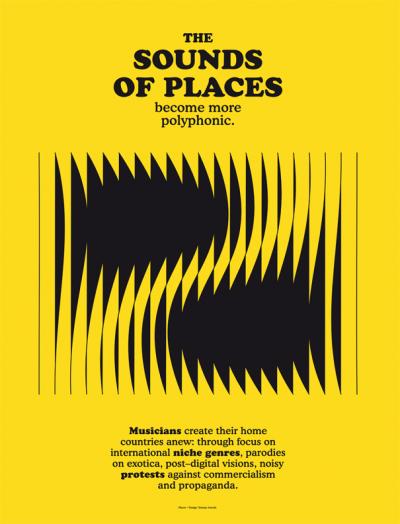Contemporary tracks remix sounds from different places and times. To analyze the manifold constellations in and shapes of these remixes is challenging. Peter J. Burkholder made a first attempt, here is yet another. From the Norient book Seismographic Sounds (see and order here).
Contemporary tracks mix samples of sounds and music from local, regional and global contexts. These samples become published on online platforms like SoundCloud, promoted via social networks, re-played in concerts and DJ-sets – settings in which they receive new attributions. Simon Reynolds describes contemporary tracks as mixtures of «time-travel» and «seance», Kodwo Eshun speaks of «sonic fictions», and Josh Kun of «audiotopia».
To research these settings systematically – and not only partial aspects of it (i.e. history of remix, copyright, practice in rap) – would offer a fascinating field of research. Probably it was Peter J. Burkholder (1994) who undertook the most extensive research attempt in that matter so far, when he analyzed «types of musical borrowing» in euro-american art music. Overwhelmed by the complexity of the task and sheer number of examples, he concluded that «the history of borrowing in Western music has yet to written» (2001: 5). Today this seems possible, with software able to keep track of great numbers, and with new possibilities to connect and publish large amounts of data in readable ways. Such an analysis would be fruitful on various levels: it would offer a path towards an analysis of music that is close to contemporary practice; it would highlight the complexities at play in each track; and it would open options to compare remix strategies over time, for example finding similarities and differences with musique concrète, soundscape composition, Plunderphonics or what Eduardo Navas calls «regenerative remixes».
Multi-disciplinary Approaches
The Burkholder update that I suggest here combines sound analysis with methods from cultural studies and ethnomusicology (interviews and participant observation, «multi-sited ethnography» (Marcus 1995), «multi(web)sited ethnography» (Koch 2013) and «digital ethnography» (Hsu 2014). Its research perspectives are: «music-making as a practice» that involves processes of music-making and production; «music as a media product» that involves reception and further processing of tracks; «musician as an actor» that involves all spheres that affect the musician as a human being and artist. The «Referenzanalysekatalog» (RAK) (catalogue to analyze the use of references) that I suggest here serves as a guideline and questionnaire: it shows the layers that are at stake when a musician remixes references from another place or time into his or her music. I define music as a media product, because cover arts, title and media appearances of the musician are each factored into how a track is perceived.
The Referenzanalysekatalog (RAK)
1) Analytical Focus
– Reference Material: What sounds are being worked with?
2) Sampling
– Input: How is this reference material sampled? (field recordings with which microphone and recorder; digital samples of pre-recorded media material)
– Selection: What is selected from the reference material and used in the new media product? (a melody, a rhythmical pattern or break, a scale, a sound, lyrics)
3) Aesthetical Remix Strategies
– Technology: With which devices is the reference material remixed? (tape, vinyl, digital sequencers)
– Editing and Manipulation: How and to what extent is the reference material edited, manipulated and altered? (tempo, running direction, filtering of frequencies, repetitions, volumes, panorama, pitch)
– Effects: Which effects are added? (delay, reverb, harmonizer, ring modulator)
– Impact: How present and recognizable is the reference material in the new media product?
4) Symbolic Processing Strategies
– Positioning: What position does the new media product take in regard to the remixed reference material? (homage, parody, total abstraction)
– Citation: Is the reference material openly cited and credited? (in booklet texts, media clippings, pictures, interviews)
– Motivation: What reasons does the producer give (in interviews, texts) for remixing the reference material?
– Knowledge: How much knowledge does the producer have of the remixed reference material?
– Relation: What is the producer’s relation to the referenced material? How does he/she feel committed to it?
5) Habitus (Position/Perspective)
– Conditions of Production: Where and how was the media product produced? (professional studio, home studio, laptop)
– Finances: What are the financial realities of the media product?
– Market Orientation: On which reception platforms is the media product sold and discussed? What new meanings get attached to the media product and to the remixed reference material on the various reception platforms?
– Location: Where do the producers of the new media product live and work?
– Status: What is the producers’ background? (cultural, social, economic, gender, educational)
6) Legal and Ethical Matters
– Legal/Ethical: What are the discussions/arguments surrounding the media product? (legal, ethical, philosophical)
The goal of the RAK is to create a systematic approach to remix culture that observes inter-relations between musical and non-musical levels and highlights discourses and controversies that are at play – when a track for example remixes sounds from a specific war (see Herbert or Clarke), or from other cultural contexts (see OY or Xander Ferreira). A large amount of analyzed examples, collected and discussed multi-locally, could lead to a typology of remix culture. This approach, I believe, would lead into ethnomusicologist Veit Erlmann’s twenty-year-old suggestion to analyze the ways in which histories of cultural, social, or political contexts «are inscribed into music» (Erlmann 1995).



